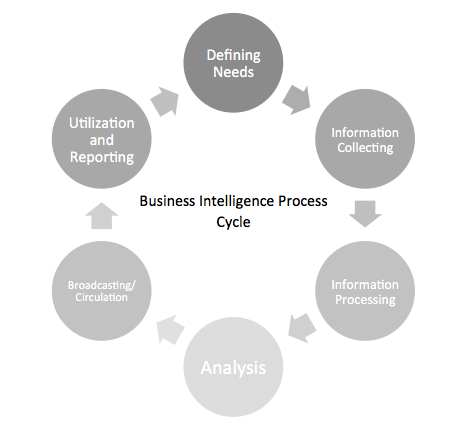Defining Your Business Information Needs
Each unique business offers their own unique product or service, so it only makes sense that each business would have unique needs when it comes to their information system requirements. Defining your business’s proprietary intelligence requirements is one of the key factors to making your business competitive in the modern industry market, so an educated decision is definitely your best bet. Business Intelligence is essentially the process in which information about your stakeholders, your competitors, and your market is collected and then analyzed to form sort of a foundation for your organization’s business decisions.
Defining your Business Intelligence needs is the first step of the Intelligence Cycle (example shown above). Generally, Business Intelligence refers to data. This data can be mined into a data mart or data warehouse and then extracted, transformed, and loaded into a localized database. It can be gathered from online surveys or questionnaires. It can be gathered from registration information from rentals, customer accounts, licenses, etc. It can be gathered from interviews or audits. It can also be gathered from trend reports and observations. (There are probably more methods, but you get the idea.) That being said, gathering requirements is essentially done the same way. Generally stakeholder interviews, financial reports, inventory reports, and business indicator analysis are used to gather a business’s requirements. However, many businesses are using a process called Joint Application Design (JAD) which incorporates key stakeholders throughout the project lifecycle. This has become popular due to the fact that requirements can change midstream sometimes, and by using JAD the additional requirements are caught before the “Implementation” stage of the life cycle resulting in saved money and time.
Once the requirements are gathered, they are then sorted into 5 categories. You have your “Need”, which is a task that is required to happen regardless of any other tasks completion. You have your “Want” which is something which is desired but has yet to be pursued. You have “Demand” which is something asked for or inquired about. You have “Use” which is where a middleman is used to purchase the information, and then you have “Requirement” which is where any or all of the aforementioned categories lay claim to the information. Discerning your business’s wants from its needs can make the Cost – Benefit Analysis a much cleaner and more efficient process, thus making this a fundamentally sound practice.
In conclusion, defining and gathering your business requirements can be done a number of ways. It doesn’t really matter how it’s gathered (as long as it is legal), it is how you store, sort, group, and analyze this information once you have it that matters. Gathering requirements is one of the most crucial steps in the Business Intelligence Process Cycle, which is why the utilization of JAD has become more popular. It allows this process to be running in the background throughout the entire life cycle of your project.
“You don’t need to know all of the answers, because no one is smart enough to ask you all of the questions.” – Unknown
